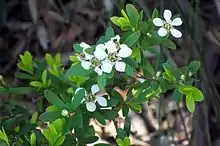Leptospermum grandifolium
The Leptospermum grandifolium, commonly known as mountain tea-tree or woolly teatree,[2] is a species of shrub or small tree that is endemic to south-eastern Australia. It has elliptical to egg-shaped leaves with a sharp point on the tip, white flowers and relatively large, broadly hemispherical fruit.
| Mountain tea-tree | |
|---|---|
 | |
| Leptospermum grandifolium in Ku-ring-gai Chase National Park | |
| Scientific classification | |
| Kingdom: | Plantae |
| Clade: | Tracheophytes |
| Clade: | Angiosperms |
| Clade: | Eudicots |
| Clade: | Rosids |
| Order: | Myrtales |
| Family: | Myrtaceae |
| Genus: | Leptospermum |
| Species: | L. grandifolium |
| Binomial name | |
| Leptospermum grandifolium | |
 | |
| Occurrence data from AVH | |
| Synonyms | |
| |
.jpg.webp)
Description
Leptospermum grandifolium is a shrub that grows to a height of about 1.5 m (4 ft 11 in) or a tree up to 10 m (33 ft) tall with smooth bark that is shed in papery strips or flakes. It has narrow egg-shaped to elliptical leaves 10–35 mm (0.39–1.38 in) long and 3–7 mm (0.12–0.28 in) wide, often with a felty surface, with a small, sharp pointed tip and a base tapering to a short petiole. The flowers are arranged singly on short side shoots on the ends of leafy branchlets and are 12–18 mm (0.47–0.71 in) or more in diameter. There are broad, pale brownish bracts and bracteoles at the base of the flower bud. The floral cup is 3–5 mm (0.12–0.20 in) long and densely hairy. The sepals are egg-shaped to triangular, 3–4 mm (0.12–0.16 in) long and densely hairy, the petals white, 4–7 mm (0.16–0.28 in) long and the stamens about 3.5 mm (0.14 in) long. Flowering occurs from October to January and the fruit is a hemispherical capsule 8–10 mm (0.31–0.39 in) wide that remains on the plant when mature with the sepals attached.[2][3][4]
Taxonomy and naming
Leptospermum grandifolium was first formally described in 1802 by James Edward Smith in Transactions of the Linnean Society of London.[5][6][7]
Distribution and habitat
Mountain tea-tree is found in the eastern half of Victoria, in the Australian Capital Territory and in south eastern New South Wales as far north as the Hawkesbury River. It grows in swamps, along rocky streams and on sheltered slopes from the coast to subalpine parts of Mount Kosciuszko.[2][4]
Cultivation
Leptospermum grandifolium is one of several Leptospermum species which are valued in cultivation.The cultivar 'Silver Sheen' is hardy in mild and coastal areas of the UK, down to −5 °C (23 °F), but requires a sheltered position. It is a recipient of the Royal Horticultural Society's Award of Garden Merit.[8]
References
- "Leptospermum grandifolium". Australian Plant Census. Retrieved 3 April 2020.
- "Leptospermum grandifolium". Royal Botanic Garden Sydney. Retrieved 3 April 2020.
- Thompson, Joy (1989). "A revision of the genus Leptospermum (Myrtaceae)". Telopea. 3 (3): 425.
- "Leptospermum grandifolium". Ryoal Botanic Gardens Victoria. Retrieved 4 April 2020.
- "Leptospermum grandifolium". APNI. Retrieved 4 April 2020.
- Smith, James Edward (1802). "Botanical characters of four New-Holland plants, of the natural order of Myrti". Transactions of the Linnean Society of London. 6: 299–300. Retrieved 4 April 2020.
- Robinson, Les (1991). Field guide to the native plants of Sydney. Kenthurst, N.S.W.: Kangaroo Press. p. 53. ISBN 0864171927.
- "Leptospermum grandifolium 'Silver Sheen'". RHS. Retrieved 1 October 2020.
